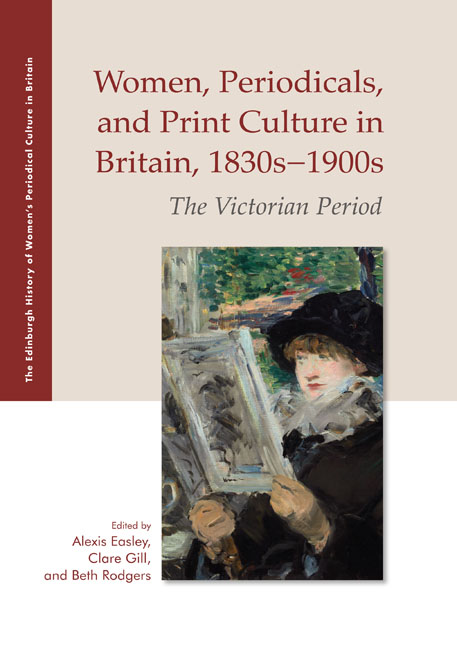Book contents
- Frontmatter
- Contents
- List of Illustrations
- Acknowledgments
- Introduction: Women, Periodicals, and Print Culture in the Victorian Period
- Part I (Re)Imagining Domestic Life
- (Re)Imagining Domestic Life: Introduction
- 1 The Rise and Rise of the Domestic Magazine: Femininity at Home in Popular Periodicals
- 2 Regulating Servants in Victorian Women's Print Media
- 3 Women Editors’ Transnational Networks in the Englishwoman's Domestic Magazine and Myra's Journal
- 4 Women and Family Health in the Mid-Victorian Family Magazine
- 5 Negotiating Female Identity in Nineteenth-Century Ireland
- 6 Women and the Welsh Newspaper Press: The Cambrian News and the Western Mail, 1870–1895
- Part II Constructing Modern Girls and Young Women
- Part III Women and Visual Culture
- Part IV Making Space for Women
- Part V Constructing Women Readers and Writers
- Part VI Intervening in Political Debates
- Notes on Contributors
- Index
- Plate section
5 - Negotiating Female Identity in Nineteenth-Century Ireland
from Part I - (Re)Imagining Domestic Life
Published online by Cambridge University Press: 25 October 2019
- Frontmatter
- Contents
- List of Illustrations
- Acknowledgments
- Introduction: Women, Periodicals, and Print Culture in the Victorian Period
- Part I (Re)Imagining Domestic Life
- (Re)Imagining Domestic Life: Introduction
- 1 The Rise and Rise of the Domestic Magazine: Femininity at Home in Popular Periodicals
- 2 Regulating Servants in Victorian Women's Print Media
- 3 Women Editors’ Transnational Networks in the Englishwoman's Domestic Magazine and Myra's Journal
- 4 Women and Family Health in the Mid-Victorian Family Magazine
- 5 Negotiating Female Identity in Nineteenth-Century Ireland
- 6 Women and the Welsh Newspaper Press: The Cambrian News and the Western Mail, 1870–1895
- Part II Constructing Modern Girls and Young Women
- Part III Women and Visual Culture
- Part IV Making Space for Women
- Part V Constructing Women Readers and Writers
- Part VI Intervening in Political Debates
- Notes on Contributors
- Index
- Plate section
Summary
ANY DISCUSSION Of the periodical press in Ireland, especially before the 1850s, must take into account the prevalence of Irish speakers over those whose mother tongue was English, the low literacy rates of native Irish speakers, and the relative paucity of books and periodicals in any language printed in Ireland. The famine of 1845–9 and the mass emigration that followed add a socio-economic layer to the problem of determining readers and reading material in the middle years of the nineteenth century. If there was little in the way of periodical literature available for readers, per se, there was even less available for Irish women. And, as a small market, Ireland was always going to be inundated with books and periodicals from England; it is therefore difficult to establish the cultural influence of Irish-produced periodicals, including those aimed at women, before the 1870s. Capitalising on a new conception of ‘Irishness,’ periodicals of the latter half of the century were often characterised either by political urgency or by a backward-looking, romantic domesticity. Even urban papers tended to valorise the rural – or rather a particular conception of the rural. This essay examines a selection of Irish titles from the 1790s to the 1870s, with a view to understanding the ways in which periodicals reflected and contributed to the development of Irish women as readers and consumers of culture.
Early Titles
To identify the first Irish periodical aimed specifically at women (if not written by them) it is necessary to delve into titles produced toward the end of the eighteenth century. Before this time, early experiments in the periodical form included the Dublin-printed Ladies Journal, which ran for twenty-two weeks in 1727. The Ladies Journal offered stories and poetry, much of it contributed by subscribers. Like many other titles published around the same time, the Journal assumed that the education of women was as important as that of ‘gentlemen,’ and it also championed copy from women. The last issue, for example, contained poetry sent in by a ‘young lady’ who, it was announced, ‘is resolv'd to stand up for the honor of her Sex, and give the Town an Idea of what might be expected from them if their Education was agreeable to their Capacity and Merit’ (29 June 1727: 171).
- Type
- Chapter
- Information
- Women, Periodicals and Print Culture in Britain, 1830s–1900sThe Victorian Period, pp. 69 - 83Publisher: Edinburgh University PressPrint publication year: 2019

